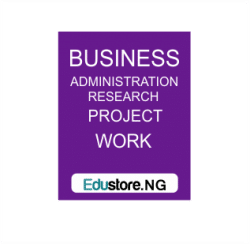TECHNIQUES OF MOTIVATING EMPLOYEES TOWARDS PEAK PERFORMANCE IN FINANCE INSTITUTION IN THE 21ST CENTURY ECONOMY
CHAPTER ONE
INTRODUCTION
1.1 BACKGROUND OF THE STUDY
Motivation, as a process, started with a need in human being which creates a vacuum in a person. In an attempt to fill the vacuum an internal driving force is generated which starts and sustains a chain of action and reaction. It is at that point that the vacuum is also filled. With this background information, Nnabuife (2009), define motivation as the internal or external driving force that produces the willingness to perform an act to a conclusive end. This first aspect of motivation we choose to describe as internal motivation because the driving force comes from within an individual. The second aspect is external motivation, is applied by the organization. This is because employees are motivated to identify with organization in order to satisfy their varied and variegates needs and desires. Until they have been identified and properly satisfied, they will never cease to impede smooth running of the organizations.
One of the biggest problems facing manager in the organizations is how best to get employees committed to their work and put in their best towards the accomplishment of organization’s objectives. Motivation is concerned with why people do what they do. It answers such questions as why do managers or worker go to work and do a good job. This tries to explain what motivates people to act the way they do, with primary focus on the work place. It is the primary task of the manager to create and maintain an environment in which employees can work efficiently and realize the objectives of the organization.
Employees differ not only in their ability to work but also in their will to do so (motivation). To motivate is to induce, persuade, stimulate, even compel, an employees to act in a manner which fulfilled the objectives of an organization. The motivation of employees depends on the strength of their motives. Motives are need, wants, desire, or impulses within the individual and these determine human behaviour. Therefore, motivation is the process of arousing behaviour, sustaining behaviour progress, and channeling behaviour into a specific curse of action. Thus, motives (needs, desire) induce employees to act. Motivation therefore is the inner state that energies people, channels and sustains human behaviour.
Since it has been established that all behavior except involving responses are goals directed, manager can apply motivational theories of management in their attempt to direct the job behaviour of employees towards the goal of their establishment.
Every organization and business wants to be successful and have desire to get consent progress. The current era is highly competitive and organizations regardless of size, technology and market focus are facing employee retention challenges. To overcome these restraints a strong and positive relationship and bonding should be created and maintained between employees and their organizations human resource or employees of any organization are the most central parts so they need to be influenced and persuaded towards task fulfillments.
For achieving prosperity, organizations design different strategies to compete with the competitors and for increasing the performance of the organizations. A very few organization believe that the human personnel and employees of any organization have its main assets to which can lead them to success or if not focused well to decline. Unless and until, the employees of any organization are satisfied with it, are motivated for the tasks fulfillment and goals achievements and encouraged, none of the organization can progress or achieve success.
Employee motivation is one of the policies of managers to increase effectual job management amongst employees in organization (shadier et al. 2009). A motivated employee is responsive of the definite goals and objectives he/she must achieve, therefore in that direction. Rutherford (1990) reported that motivation formulates an organization more successful because provoked employee are constantly looking for improved practices to do a work, so it is essential for organizations to persuade motivation of their employees (Kalimullah et al 2010) Getting employee to do their best work even in strenuous circumstances is one of the employees most stable and greasy challenge and this can be made possible through motivating them.
1.2 STATEMENT OF THE PROBLEM
Workers leave organization due to the fact that they are not motivated enough. Some are not willing to leave because they are enjoying some benefit in terms of promotion, which leads to increase in salaries and wages, bonus and some other incentives.
The workers of financial institutions in Eket will prefer financial incentives to non financial incentives, more especially the junior workers, due to the fact that such incentives are not used as a motivational technique, the company have the problem and challenges of retention of their employees. Hence low performance and productivity becomes the end result and finally work dissatisfaction.
1.3 OBJECTIVES OF THE STUDY
i) To investigate the motivational techniques adopted by the AKwa Savings and Loans Limited, Eket to retain her employees.
ii) To examine the response of the employees to motivational techniques adopted by the financial institutions in Nigeria.
iii) To find out the problem hindering the success of the employee’s motivation in AKwa Savings and Loans Limited, Eket.
iv) To ascertain if motivation lead to higher performance and productivity.
v) To make recommendations and suggestions based on the findings of this study.
1.4 RESEARCH QUESTIONS
i) What are the motivational techniques adopted by the Akwa Savings and Loans Limited to retain her employees?
ii) How responsive is the employees to motivational reward adopted by the company?
iii) What are the factors hindering the success of employee’s motivation in the company?
iv) Which of the incentives given to the employees lead them to higher performance and productivity?
1.5 RESEARCH HYPOTHESES
HYPOTHESIS 1
H0: The motivational techniques adopted by AKwa Savings and Loans Limited, Eket do not significantly lead to retention of the employees.
H1: The motivational techniques adopted by AKwa Savings and Loans Limited, Eket do significantly lead to retention of the employees.
HYPOTHESIS 2
H0: The employees do not significantly respond to the motivational rewards adopted by the company.
H1: The employees do significantly respond to the motivational rewards adopted by the company.
1.6 SIGNIFICANCE OF THE STUDY
The findings from this study will help to highlight those areas where there are problems among staff and thus will be of great benefit to the management of organizations and policy makers. The results of this study would hopefully be significant in the sense that it would enable both the management and the labour union to better understand how the various incentive packages could be harnessed to inspire staff to increase and sustain productivity.
The findings from this study would help to further highlight the likely problems of frustrations and how motivation can be used to either reduce or eliminate these problems amongst staff of the organization. The results from this study will help to highlight the concept of group dynamics and staff behaviour to work. Through such understanding, the administrative scope of the chief executives official could be broadened and this would put him in a better position to review and over-haul their orientation to administration in terms of better motivating staff and thus producing better results by fully utilizing the human resources potentials available.
Furthermore this study will be of immense benefit to policy makers in the human resources functions of the organizations. Also labour union officials and representative at the negotiation meeting will find it useful when putting together their “basket of needs” and it will assist management in these other areas:
i) Designing and putting in place together welfare incentives for the workforce
ii) Enables the organization identifies various types of needs and expectation of people at work.
iii) Outline different approach to work motivation.
iv) Explain the meaning and underlying concert of motivation.
1.7 SCOPE OF THE STUDY
The study concerns about techniques of motivating employees towards peak performance in finance institution in the 21st century economy with a particular reference to Akwa Savings and Loans Limited, Eket.
1.8 DEFINITION OF TERMS
MOTIVATION: Motivation is define as the internal or external driving force that produces the willingness to perform an act to a conclusive end Nnabuife (2009).
TECHNIQUES: This is a systematic method, procedure, formula, or routine by which a particular task is accomplished (Clement, 2015).
EMPLOYEE: This define as an individual who works as a part-time or full-time under a contract of employment, whether oral or written, express or implied, and has recognized rights and duties.
PERFORMANCE: The accomplishment of a given task measured against preset known standards of accuracy, completeness, cost and speed. In a contract, performance is deemed to be the fulfillment of an obligation in a manner that releases the performer from all liabilities under the contract.
PRODUCTIVTY: Productivity is defined as the ratio of the output (good and services) and input (Labour, capital or management) Mojahed, (2005).
DOWNLOAD COMPLETE WORK- For Reference Only: Materials are for research, citation, and idea generation purposes and not for submission as your original final year project work.
- Avoid Plagiarism: Do not copy or submit this content as your own project. Doing so may result in academic consequences.
- Use as a Framework: This complete project research material should guide the development of your own final year project work.
- Academic Access: This platform is designed to reduce the stress of visiting school libraries by providing easy access to research materials.
- Institutional Support: Tertiary institutions encourage the review of previous academic works such as journals and theses.
- Open Education: The site is maintained through paid subscriptions to continue offering open access educational resources.






